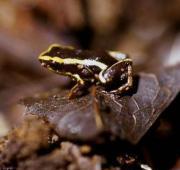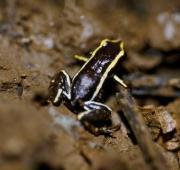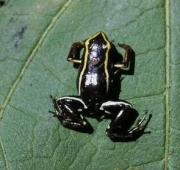 The Monte Iberia Eleuth is a tiny species of frog that, as it's name suggests, is natively found in the woodlands around Mount Iberia. The Monte Iberia Eleuth is the smallest species of frog in the Northern Hemisphere and is the second smallest species of frog in the world behind the Brazilian Golden frog found in Brazil, average less than 1cm in length.
The Monte Iberia Eleuth is a tiny species of frog that, as it's name suggests, is natively found in the woodlands around Mount Iberia. The Monte Iberia Eleuth is the smallest species of frog in the Northern Hemisphere and is the second smallest species of frog in the world behind the Brazilian Golden frog found in Brazil, average less than 1cm in length. The Monte Iberia Eleuth is a critically endangered animal that is confined to just two remote areas of forest in Cuba. The Monte Iberia Eleuth was first discovered on Mount Iberia in 1996, and populations are known to be very vulnerable as this frog is only found in very specific habitats that include areas of closed rainforest, with poorly drained soil and high levels of humidity.
The Monte Iberia Eleuth is a critically endangered animal that is confined to just two remote areas of forest in Cuba. The Monte Iberia Eleuth was first discovered on Mount Iberia in 1996, and populations are known to be very vulnerable as this frog is only found in very specific habitats that include areas of closed rainforest, with poorly drained soil and high levels of humidity.


Despite it's miniature size, the Monte Iberia Eleuth has a very similar diet to other small frogs, hunting and eating a wide range of invertebrates in the Cuban jungle. The Monte Iberia Eleuth feeds on insects, moths and spiders along with a number of semi-aquatic invertebrates when it is close to water.
Due to it's small size, the Monte Iberia Eleuth has numerous predators within it's natural environment including birds, rodents, lizards, toads and even larger frogs. The Monte Iberia Eleuth is also an incredibly sensitive animal that is easily affected by changes to it's environment including pollution and deforestation.
Little is known about the reproduction of the smallest frog in the Northern Hemisphere, besides the fact that once hatched, the life-cycle of the Monte Iberia Eleuth is similar to that of other frogs turning from water-based tadpoles to ground-dwelling frogs. When the first Monte Iberia Eleuth frog was found, she was found next to a single egg which indicates that this species reproduces slowly as they don't lay hundreds of eggs at once.
Today, the Monte Iberia Eleuth is considered to be an animal that is critically endangered in the wild and therefore population numbers are very low in the wild.

